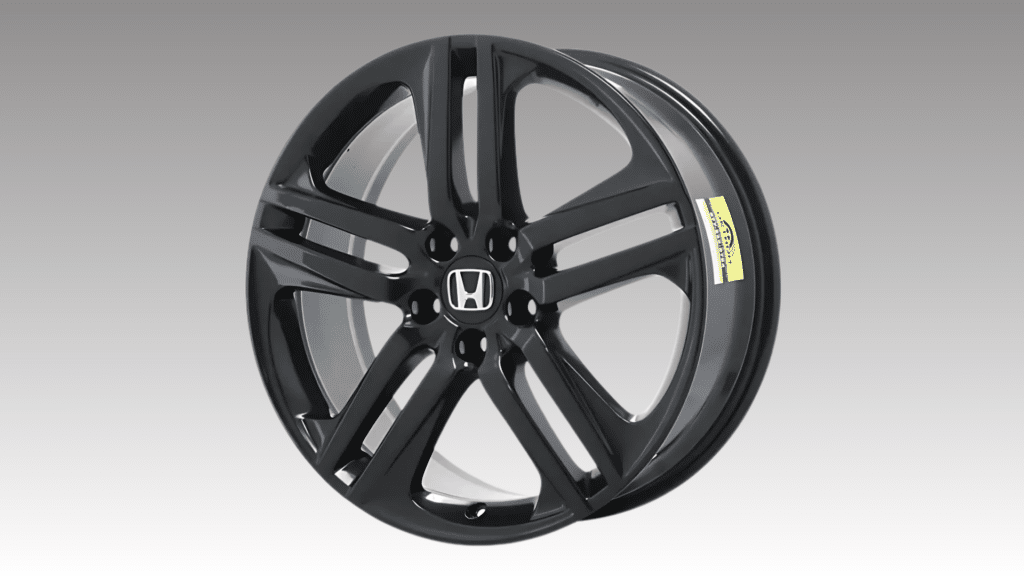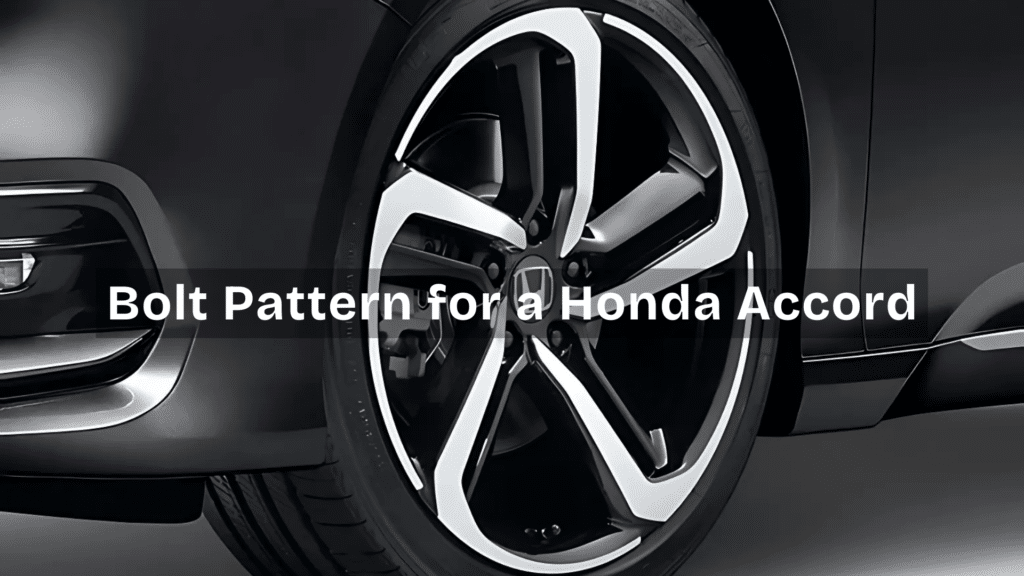If you’re thinking about upgrading your wheels or replacing old ones, knowing your Honda Accord’s bolt pattern is important.
The bolt pattern tells you how many lug nuts your wheels have and how far apart they are. If the pattern doesn’t match, the wheels won’t fit properly, no matter what.
Most Honda Accords have a 5×114.3 bolt pattern, which means five lug nuts spaced 114.3 millimeters apart in a circular pattern.
However, some older models may have a different pattern, so it’s always a good idea to double-check before buying new wheels.
In this blog, I’ll explain what a bolt pattern is, how to measure it, and which bolt pattern different Honda Accords use. I’ll also share tips for choosing the right wheels so you can avoid mistakes and get the perfect fit.
What is a Bolt Pattern and Why Does it Matter?

A bolt pattern is how the lug nuts on a wheel are arranged. It tells you how many lug nuts there are and how far apart they are spaced.
For example, a 5×114.3 bolt pattern means the wheel has five lug nuts spaced 114.3 millimeters apart in a circle.
The bolt pattern must match exactly for the wheels to fit. Even if the wheels look right, the wrong pattern means they won’t bolt on properly. Here’s why that’s important:
- Proper Fit: If the bolt pattern is wrong, the wheels will not align with the lug nuts.
- Safety: A bad fit can cause wobbling, vibrations, or loose wheels, which can be dangerous.
- Smooth Ride: The right fit helps with better handling, even tire wear, and stability.
Before buying new wheels, always check your Honda Accord’s bolt pattern to avoid problems!
Honda Accord Bolt Pattern
Knowing your Honda Accord’s bolt pattern is important if you’re changing or upgrading your wheels. If the bolt pattern doesn’t match, the wheels won’t fit properly, leading to poor handling and safety issues.
Honda Accords have used two different bolt patterns over the years:
- 1976–1989 Honda Accord: 4×100 (4 lug nuts, 100mm apart)
- 1990–2024 Honda Accord: 5×114.3 (5 lug nuts, 114.3mm apart)
Most Honda Accords from 1990 and newer use a 5×114.3 bolt pattern, which is the same as many Honda and Acura models. If you have an older Accord (before 1990), you will need wheels with a 4×100 bolt pattern instead.
How to Measure Your Bolt Pattern
If you’re unsure about your Accord’s bolt pattern, you can measure it yourself with a measuring tape.
1. Count the Lug Nuts
- Older Honda Accords (1976–1989) have 4 lug nuts.
- Newer Honda Accords (1990–present) have 5 lug nuts.
2. Measure the Bolt Circle
- For a 4-lug pattern (4×100): Measure from the center of one lug nut to the center of the lug nut directly across from it.
- For a 5-lug pattern (5×114.3): Measure from the center of one lug nut to the outer edge of the lug nut directly across from it.
3. Check Your Measurement
- If the distance is 100mm (for 4-lug) or 114.3mm (for 5-lug), that is your bolt pattern.
Before buying new wheels, always double-check your Honda Accord’s bolt pattern to ensure a perfect fit. Even a small difference in measurement can make wheels impossible to install.
Choosing the Right Wheels for a Honda Accord Bolt Pattern
When upgrading or replacing your Honda Accord’s wheels, the most important thing is ensuring they fit properly.
If the bolt pattern and other measurements are incorrect, the wheels won’t bolt on securely, which can cause wobbling, uneven tire wear, or even damage to your car.
Here’s what to check before buying new wheels.
1. Check Your Bolt Pattern
- 1976–1989 Honda Accord: 4×100 (4 lug nuts, 100mm apart)
- 1990–2024 Honda Accord: 5×114.3 (5 lug nuts, 114.3mm apart)
Your wheels must match your exact bolt pattern. If they don’t, they won’t fit properly, no matter the size.
2. Choose the Right Wheel Size
Most Honda Accords come with wheels between 16 and 19 inches from the factory. Here’s what to consider:
- 16- to 17-inch wheels: Best for a smooth ride and fuel efficiency.
- 18- to 19-inch wheels: Offers a sportier look and better handling.
- 20-inch wheels or bigger: Looks aggressive but may affect ride comfort.
If you increase wheel size, make sure your tires match to avoid speedometer issues and rubbing.
3. Pay Attention to Offset
Offset determines how far the wheels sit in or out from the fender.
- Too much positive offset: Wheels sit too far inside and may hit the suspension.
- Too much negative offset: Wheels stick out too much and may cause rubbing.
For most Honda Accords, a +35 to +50 offset works best.
4. Match the Hub Bore Size
The hub bore is the hole in the center of the wheel. It must match your car’s hub for a snug fit. If the bore is too big, you may need hub-centric rings to prevent vibrations. If it’s too small, the wheel won’t fit at all.
5. Use the Right Lug Nuts
Some aftermarket wheels require different lug nuts than factory wheels. Using the wrong ones can lead to loose wheels or stripped threads. Always check if your new wheels need conical, flat, or spline lug nuts.
Choosing the right wheels for your Honda Accord’s bolt pattern means checking the bolt pattern, wheel size, offset, hub bore, and lug nuts before buying. Taking the time to get the perfect fit will keep your car safe, smooth, and stylish.
Wheel Recommendations for Honda Accord Bolt Pattern
If you are looking for new wheels for your Honda Accord, you need ones that fit properly, look great, and improve performance. The most important thing is to make sure they match the bolt pattern and other fitment details.
Most Honda Accords from 1990 and newer use a 5×114.3 bolt pattern, while older models (before 1990) use 4×100. Here are some of the best wheel options based on style, budget, and driving needs.
1. Best All-Around Wheels – Great for Daily Driving
- Enkei RPF1: Lightweight, strong, and improves handling
- Konig Hypergram: Sporty look with great durability
- Motegi MR116: Simple design, affordable, and reliable
2. Best Performance Wheels – For Better Handling and Speed
- Volk TE37: High-quality, lightweight racing wheels
- Rays Gram Lights 57CR: Built for performance with aggressive styling
- Advan RGIII: Excellent grip and stability at high speeds
3. Best Budget Wheels – Good Quality Without Overspending
- XXR 527: Stylish and affordable for a sporty look
- Konig Dekagram: Strong, lightweight, and reasonably priced
- Touren TR60: Simple, clean design with a budget-friendly price
4. Best OEM-Style Wheels – Stock Look With an Upgrade
- Honda Accord Sport Wheels (OEM): Keeps a factory look but sportier
- Acura TL Type-S Wheels: A clean upgrade that fits many Accords
- Enkei TSP6: OEM-style with lightweight performance
Choosing the right wheels makes a big difference in how your Honda Accord looks and drives. Make sure to double-check fitment before buying to avoid any problems. The right wheels will keep your car safe, stylish, and smooth on the road.
Helpful Tips for Choosing Wheels for Your Honda Accord
Picking the right wheels for your Honda Accord is more than just choosing a style. If the wheels don’t fit properly, they can cause problems like wobbling, poor handling, or tire wear. Here are some simple tips to help you find the perfect fit.
1. Check Your Bolt Pattern: Most Honda Accords from 1990 and newer use a 5×114.3 bolt pattern. Older models use 4×100. If the bolt pattern doesn’t match, the wheels won’t fit.
2. Pick the Right Wheel Size:
- 16-17 inches: Smooth ride, better fuel economy.
- 18-19 inches: A mix of style and performance.
- 20 inches or larger: Aggressive look but may affect comfort.
3. Pay Attention to Offset: Offset determines how far the wheel sits inside or outside the fender. The wrong offset can cause rubbing or handling issues. A safe range for most Accords is +35 to +50.
4. Match the Hub Bore Size: The hub bore is the hole in the center of the wheel. If it’s too small, the wheel won’t fit. If it’s too big, you may need hub-centric rings to prevent vibrations.
5. Use the Right Lug Nuts: Some aftermarket wheels need special lug nuts. Using the wrong type can lead to loose wheels or stripped threads, which is dangerous.
6. Make Sure Tires Match the Wheels: If you change the wheel size, your tires must match to keep your ride smooth and your speedometer accurate.
7. Buy From a Trusted Seller: Check reviews and make sure you’re buying from a reliable store. Good places to buy wheels include Tire Rack, fitment industries, Discount Tire, and local wheel shops
Take your time to find the right wheels for your Honda Accord. Checking the bolt pattern, size, offset, and hub bore before buying will save you money.
Conclusion
Choosing the right wheels for your Honda Accord is not just about looks—it’s about fit, safety, and performance. If the bolt pattern, size, or offset is wrong, the wheels won’t fit properly, leading to wobbling, uneven tire wear, and handling issues.
Before buying new wheels, always double-check your bolt pattern (most Accords use 5×114.3) and make sure the size is right for your car.
Pay attention to offset, hub bore size, and lug nut type to avoid any fitment problems. If you’re changing wheel size, make sure your tires match so your car drives smoothly.
A little research now can save you money and prevent mistakes later. The right wheels will not only improve your Accord’s appearance but also keep it safe and comfortable on the road.
Frequently Asked Questions
What size wheels fit a Honda Accord?
Most Accords come with wheels between 16 and 19 inches from the factory. You can go bigger or smaller, but always make sure the offset and tire size match to avoid problems.
Where can I buy wheels for my Honda Accord?
You can buy wheels from Tire Rack, Discount Tire, Fitment Industries, and local wheel shops. Always check the bolt pattern, offset, and hub bore size before purchasing.
Will changing wheel size affect my speedometer?
Yes, if the overall tire diameter changes, your speedometer can be inaccurate. Use a tire size calculator to keep the diameter close to stock.
Can I use wheels from another Honda model on my Accord?
Some Honda and Acura wheels fit if they share the 5×114.3 bolt pattern, but you must also check offset, hub bore size, and wheel width for a proper fit.
Do I need wheel spacers for my Honda Accord?
Wheel spacers are only needed if your wheels sit too far inside and rub against the suspension. However, using them incorrectly can affect handling and safety.


